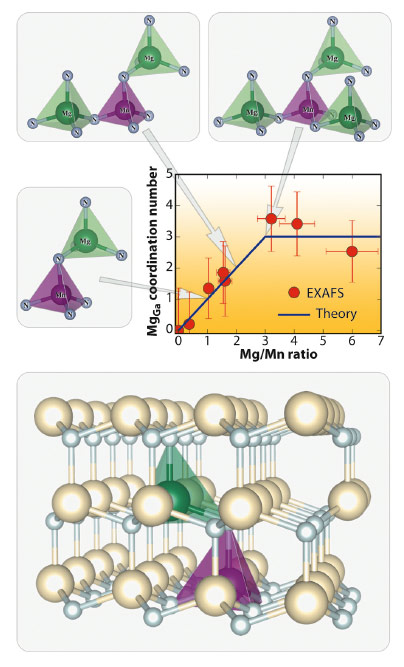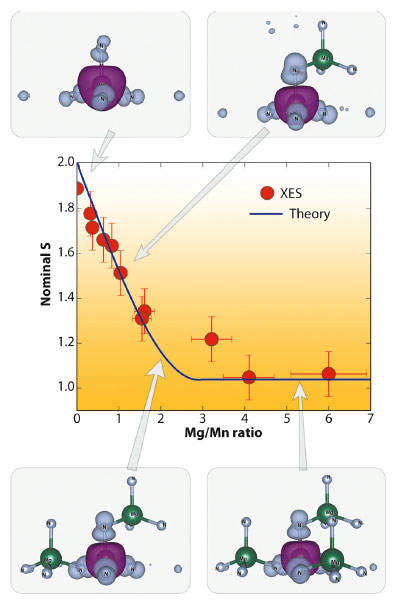- Home
- Users & Science
- Scientific Documentation
- ESRF Highlights
- ESRF Highlights 2012
- Dynamics and extreme conditions
- Magnetic complexes: a way to combine magnetism and photonics in semiconductors
Magnetic complexes: a way to combine magnetism and photonics in semiconductors
Due to their unique photonic properties and to the possibility of tuning the band gap over an exceptionally wide energy range, gallium nitride (GaN) and related compounds are considered as technologically outstanding semiconductors. Most of the commercial light emitting diodes (LEDs) are currently based on GaN. Moreover, this material – once homogeneously doped with transition metal ions and with a considerable amount of free holes – has been predicted to be the ideal candidate for ferromagnetic semiconductor with spintronic functionalities above room temperature [1]. The epitaxial growth of these systems can be reliably directed by taking advantage of specific features of magnetic impurities in semiconductors. This can result in either a dilute, homogeneous alloy [2] or a condensed, inhomogeneous system with the self-organised aggregation of magnetically robust nanocrystals embedded in the host paramagnetic matrix and with specific signatures crucially depending on the crystallographic phase of the specific nanocrystals [3].
The examples given above have been only possible through the development of a protocol of comprehensive structural, magnetic and chemical characterisation supported by an extensive theoretical investigation and feedback. In particular, synchrotron absorption and diffraction, and advanced electron microscopy have permitted significant advances.
These advances have led recently to the discovery of magnetic nitride complexes involving one magnetic impurity and one or more electrically active dopants. Using synchrotron radiation methods supported by ab initio computations, it has been possible to show that the codoping of GaN with Mn (magnetic species) and Mg (acceptors) results in the formation of cation complexes Mn–Mgk where the number of ligands k is dictated by the synthesis conditions.
From extended X-ray absorption fine structure (EXAFS) measurements carried out at beamline BM08 (GILDA Italian beamline) at the Mn K-edge and by ab initio computation based on density functional theory (DFT), a correlation was found between the positions occupied by Mn and Mg in the host lattice, instead of uniform distribution. As summarised in Figure 41, the number of Mg cations neighbouring each Mn follows the Mg/Mn ratio in the sample, it increases linearly up to Mg/Mn = 3 and then becomes saturated. This configuration corresponds to the energetically most favourable cation complexes identified by DFT.
 |
|
Fig. 41: Number of Mg atoms neighbouring each Mn in the first cation coordination sphere (MgGa), extracted from EXAFS analysis and compared to the energetically most favourable configurations found by ab initio computations. The arrows correlate the theoretical and experimental values to the corresponding Mn-Mg complexes. |
The theoretical expectations are also confirmed by following the evolution of the Mn spin state S as a function of Mg codoping. This is obtained via the Kβ X-ray emission spectroscopy (XES) technique, which – by probing the 3p  1s transitions – is sensitive to the magnitude of the exchange interaction between the Mn 3p core-hole and the net magnetic moment in the Mn 3d valence shell. From the XES spectra, collected at beamline ID26, the values of S are obtained. These are reported in Figure 42 together with calculated spin-polarisation densities. With this analysis, it was possible to demonstrate that, upon Mg codoping, the Mn spin state first decreases linearly from 2 to 1, and then saturates for Mg/Mn > 3.
1s transitions – is sensitive to the magnitude of the exchange interaction between the Mn 3p core-hole and the net magnetic moment in the Mn 3d valence shell. From the XES spectra, collected at beamline ID26, the values of S are obtained. These are reported in Figure 42 together with calculated spin-polarisation densities. With this analysis, it was possible to demonstrate that, upon Mg codoping, the Mn spin state first decreases linearly from 2 to 1, and then saturates for Mg/Mn > 3.
 |
|
Fig. 42: Nominal spin state S as a function of the ratio between the Mg and Mn concentration, extracted from the analysis of XES spectra and supported by ab initio computations. The arrows correlate the experimental values to the corresponding calculated spin polarisation densities. |
The formation of the paramagnetic complexes has two surprising consequences: (i) in the combination 1 Mn – 1 Mg, the observed delocalisation of the hole-states holds promise for the realisation of the long-pursued carrier-mediated high-temperature ferromagnetic interaction between magnetic spins in a semiconducting matrix, and (ii) in the case of complexes involving three Mg ligands, photoluminescence revealed a broad infrared band covering two of the principal telecommunication windows, namely 1.33 µm and 1.55 µm.
Principal publication and authors
T. Devillers (a), M. Rovezzi (b), N. Gonzalez Szwacki (c), S. Dobkowska (d), W. Stefanowicz (d), D. Sztenkiel (d), A. Grois (a), J. Suffczy´nski (e), A. Navarro-Quezada (a), B. Faina (a), Tian Li (a), P. Glatzel (b), F. d’Acapito (f), R. Jakieła (d), M. Sawicki (d), J.A. Majewski (c), T. Dietl (c) and A. Bonanni (a), Scientific Reports 2, 722 (2012).
(a) Institut für Halbleiter und Festkörperphysik, Johannes Kepler University, Linz (Austria)
(b) ESRF
(c) Institute of Theoretical Physics, Faculty of Physics, University of Warsaw (Poland)
(d) Institute of Physics, Polish Academy of Sciences, Warsaw (Poland)
(e) Institute of Experimental Physics, Faculty of Physics, University of Warsaw (Poland)
(f) Consiglio Nazionale delle Ricerche, IOM-OGG c/o ESRF GILDA CRG, Grenoble (France)
References
[1] T. Dietl, H. Ohno, F. Matsukura, J. Cibert and D. Ferrand, Science 287, 1019 (2000).
[2] M. Sawicki, T. Devillers, S. Gałeski, C. Simserides, S. Dobkowska, B. Faina, A. Grois, A. Navarro-Quezada, K.N. Trohidou, J.A. Majewski, T. Dietl and A. Bonanni, Phys. Rev. B 85, 205204 (2011).
[3] A. Bonanni, A. Navarro-Quezada, T. Li, M. Wegscheider, Z. Matej, V. Holy, R.T. Lechner, G. Bauer, M. Rovezzi, F. D’Acapito, M. Kiecana, M. Sawicki and T. Dietl, Phys. Rev. Lett. 101, 135502 (2008).



